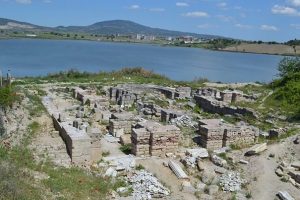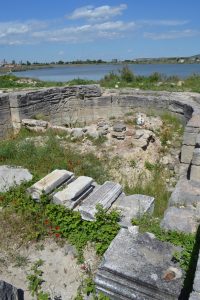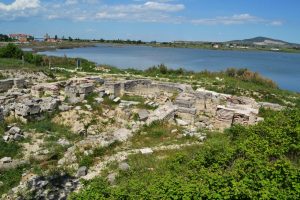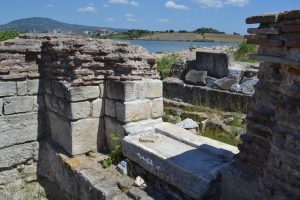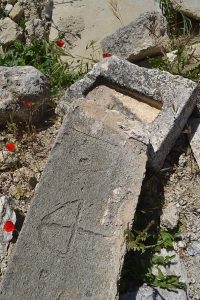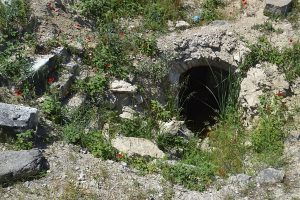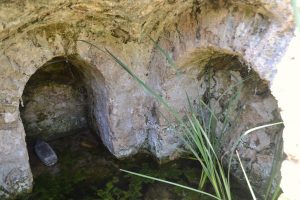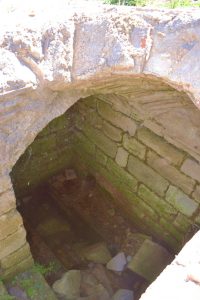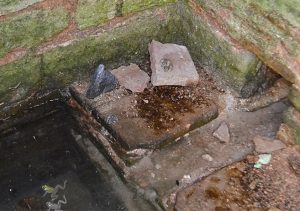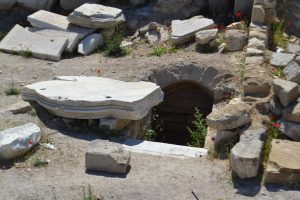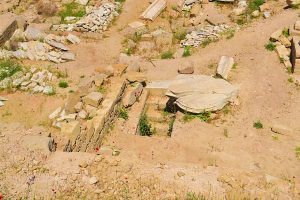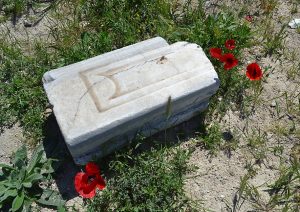This is a large basilica on the lake shore to the east of the citadel. Excavation was begun by the team from the University of Istanbul in the 1980s and parts still remain undergound. It is a large affair, around 30m long with a central nave flanked by aisles leading to pastaphoria and chapels outside those. The arrangement is visible on the photo above. The main apse is in the centre of the picture with the central entrance partially buried and the entrance to the southern chapel still unexcavated. The second entrance from left leads to a pastaphorion, the site of the most intricate stepped stonework.
The photo above shows the interior of the central apse. The outside is polygonal with three sides and the inner surface displays some lovely stonecutting and laying skills. It is in this section of the church that the finest sculptural detail may be seen in the remaining marble fragments.
This picture was taken from above the (largely unexcavated) wall between the south aisle and the southern pastaphorion. According to the information on-site, there were seven different building phases, the earliest in Roman times. The exposed floor plan gives a good idea of the appearance of the church in its final incarnation in the 12th century. The four central stone pillars in the middle aisle presumably supported a large dome. The reinforced brickwork around the pastaphoria would have supported smaller domes outside and to the east of the central dome.
The picture above shows the entry from a pastaphorion into the southern aisle. The stonework and marble display craftsmanship of a degree of care and attention characteristic of the time around the sixth century. The eastern side of the church with the three apses may come from this time. A cache of coins from about the twelfth century seems to show that the church may have been disused from that time. It was buried by centuries of sediment before being dug up by the team from the University of Istanbul. Stonework on the western part of the basilica seems to be of a rather more rough standard, particularly in the sections of the narthex that appeared in the most recent excavations. Sait Başaran, the archaeologist associated most closely with Enez in general and Kral Kızı Bazilikası in particular, has discovered traces of high quality mosaic tile, stained glass and fresco that indicate that this must have been a richly appointed church. Presumably, it did not become a mosque or tomb after conquest by Mehmet II and consequently it crumbled and was buried by sediment.
Some of the carved crosses on the outside of the church appear to be devotional graffiti made by worshippers who wished to leave their mark on the building.
Beneath the central aisle is an ayazma (sacred spring/fountain) with an arched entrance from the south and three niches at water level in the directions of the other three compass points. This is lovely and cool in summer and is populated by noisy and promiscuous frogs.
Another ayazma has been unearthed in the western section of the church, probably beneath a narthex. This one is larger, lacks the delicacy of the stonework of the one in the nave but has a similar population of reproducing frogs.
This fountain is, however, associated with some nice marble work.
It must have been part of a sanctuary at some stage in the church’s history.
Excavations will proceed more slowly now that efforts are being concentrated on the restoration of Fatih Camii.
Başaran, S. (2008) Trakya’da bir Prenslik Merkzi: Ainos Antik Kenti. Osmanlı Bankası Arşiv ve Arıştırma Merkeziç Available online at: http://www.obarsiv.com/pdf/sait_basaran.pdf Accessed 31st May 2017
Ousterhout, R. and C. Bakirtzis (2007) The Byzantine Monuments of the Evros/Meriç Valley. European Center for Byzantine and Post-Byzantine Monuments. Available online at: https://issuu.com/ekbmm.gr/docs/evros_meric Accessed 25th May 2017
Tanindi, O., Ö. Kurt et al. (2009) Kral Kızı Bazilikası, TAY (Türkiye Arkeoljik Yerleşmelerı) Available online at: http://www.tayproject.org/TAYBizansMar.fm$Retrieve?YerlesmeNo=20248&html=bizansdetaile.html&layout=web Accessed 29th May, 2017

Categories: Uncategorized | No Comments »
